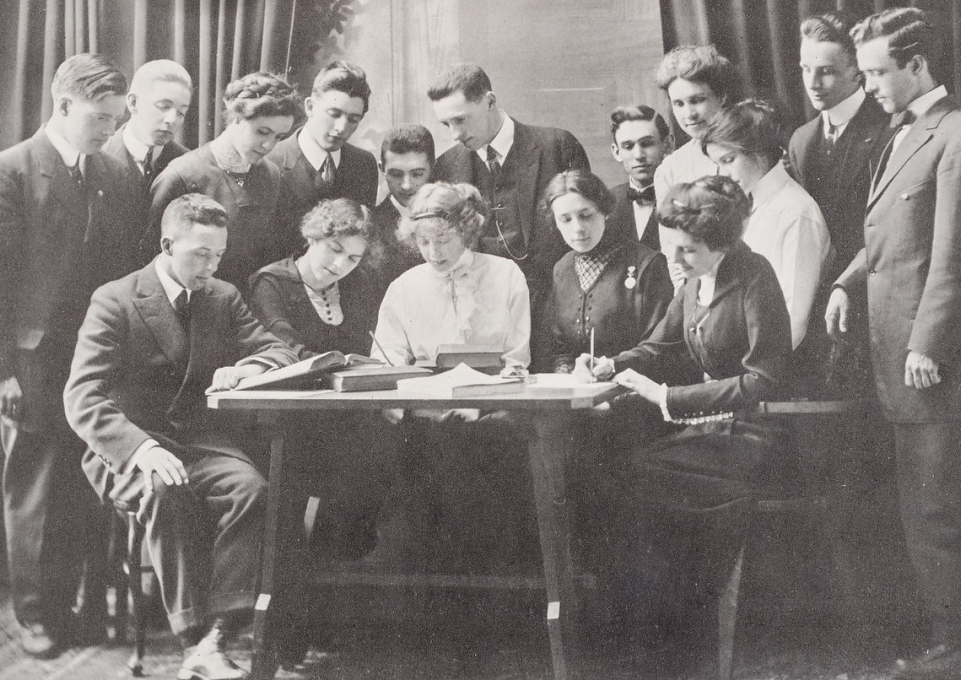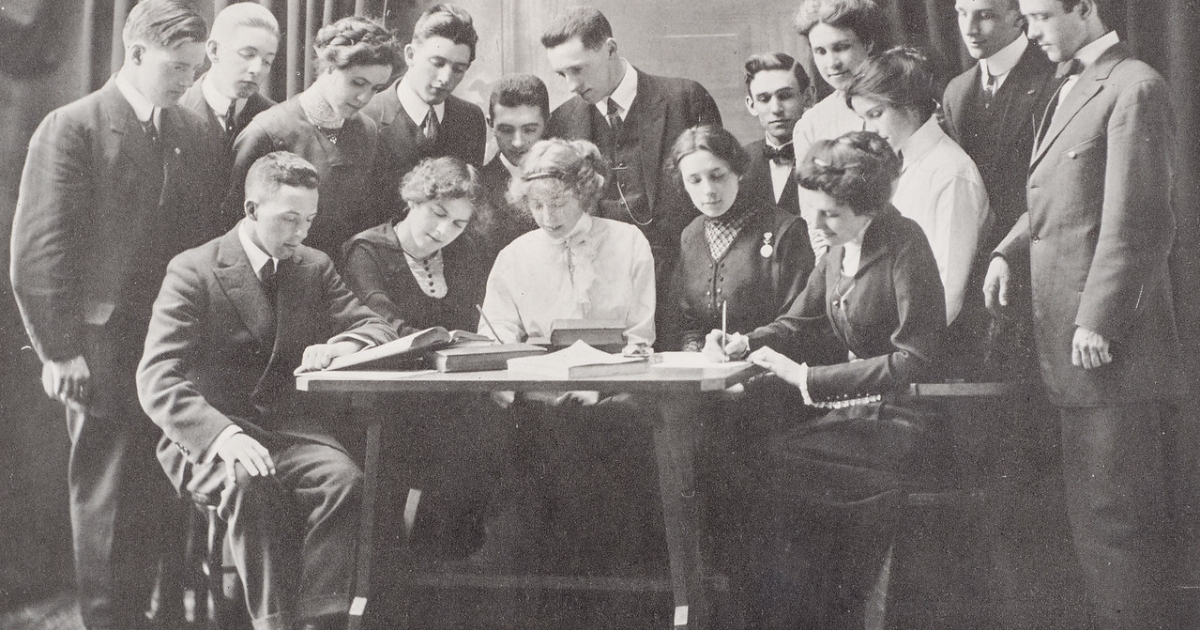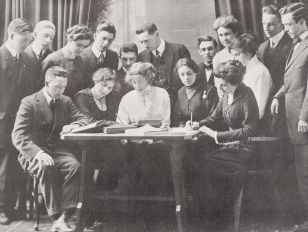
In 1600s and 1700s America, prior to the first and second Industrial Revolutions, educational opportunity varied widely depending on region, race, gender, and social class.
Public education, common in New England, was class-based, and the working class received few benefits, if any. Instructional styles and the nature of the curriculum were locally determined. Teachers themselves were expected to be models of strict moral behavior.
By the mid-1800s, most states had accepted three basic assumptions governing public education: that schools should be free and supported by taxes, that teachers should be trained, and that children should be required to attend school.
The term “normal school” is based on the French école normale, a sixteenth-century model school with model classrooms where model teaching practices were taught to teacher candidates. In the United States, normal schools were developed and built primarily to train elementary-level teachers for the public schools.
The Normal School
The term “normal school” is based on the French école normale, a sixteenth-century model school with model classrooms where model teaching practices were taught to teacher candidates. This was a laboratory school where children on both the primary or secondary levels were taught, and where their teachers, and the instructors of those teachers, learned together in the same building. This model was employed from the inception of the Buffalo Normal School, where the “School of Practice” inhabited the first floors of the teacher preparation academy. In testament to its effectiveness, the Campus School continued in the same tradition after the college was incorporated and relocated on the Elmwood campus.
Earlier normal schools were reserved for men in Europe for many years, as men were thought to have greater intellectual capacity for scholarship than women. This changed (fortunately) during the nineteenth century, when women were more successful as private tutors than were men.
In the late nineteenth and early twentieth centuries, newly industrialized European economies needed a reliable, reproducible, and uniform work force. The preparation of teachers to accomplish this goal became ever more important. The process of instilling in future citizens the norms of moral behavior led to the creation of the first uniform, formalized national educational curriculum. Thus, “normal” schools were tasked with developing this new curriculum and the techniques through which teachers would communicate and model these ideas, behaviors, and values for students who, it was hoped, through formal education, might desire and seek a better quality of life.
In the United States, normal schools were developed and built primarily to train elementary-level teachers for the public schools. In 1823, Reverend Samuel Read Hall founded the first private normal school in the United States, the Columbian School in Concord, Vermont. The first public normal school in the United States was founded shortly thereafter in 1839 in Lexington, Massachusetts. Both public and private “normals” initially offered a two-year course beyond the secondary level, but by the twentieth century, teacher-training programs required a minimum of four years. By the 1930s most normal schools had become “teachers colleges,” and by the 1950s they had evolved into distinct academic departments or schools of education within universities.
The Buffalo Normal School
Buffalo State was founded in 1871 as the Buffalo Normal School. It changed its name more often than it changed its building. It has been called the State Normal and Training School (1888–1927), the State Teachers College at Buffalo (1928–1946), the New York State College for Teachers at Buffalo (1946–1950), SUNY, New York State College for Teachers (1950–1951), the State University College for Teachers at Buffalo (1951–1959), the State University College of Education at Buffalo (1960–1961), and finally the State University College at Buffalo in 1962, or as we know it more succinctly, SUNY Buffalo State College.
As early as the 1800s, visionary teachers explored teaching people with disabilities. Thomas Galludet developed a method to educate the deaf and hearing impaired. Dr. Samuel Howe focused on teaching the visually impaired, creating books with large, raised letters to assist people with sight impairments to “read” with their fingers.
What Goes Around, Comes Around: What Is Good Teaching?
Throughout most of post-Renaissance history, teachers were most often male scholars or clergymen who were the elite literates who had no formal training in “how” to teach the content in which they were most well-versed. Many accepted the tenet that “teachers were born, not made.” It was not until “pedagogy,” the “art and science of teaching,” attained a theoretical respectability that the training of educated individuals in the science of teaching was considered important.
While scholars of other natural and social sciences still debate the scholarship behind the “science” of teaching, even those who accept pedagogy as a science admit that there is reason to support one theory that people can be “born” with the predisposition to be a good teacher. Even today, while teacher education programs are held accountable by accreditors for “what” they teach teachers, the “dispositions of teaching” are widely debated, yet considered essential to assess the suitability of a teacher candidate to the complexities of the profession. Since the nineteenth century, however, pedagogy has attempted to define the minimal characteristics needed to qualify a person as a teacher. These have remained fairly constant as the bases for educator preparation programs across the country: knowledge of subject matter, knowledge of teaching methods, and practical experience in applying both are still the norm. The establishment of the “norms” of pedagogy and curriculum, hence the original name of “normal school” for teacher training institutions, recognized the social benefit and moral value of ensuring a quality education for all.
As with so many innovations and trends that swept the post-industrial world in the twentieth century, education, too, has experienced many changes. The names of the great educational theorists and reformers of the Progressive Era in education are known to all who know even a little about teaching and learning: Jean Piaget, Benjamin Bloom, Maria Montessori, Horace Mann, and John Dewey to name only a few.
As early as the 1800s, visionary teachers explored teaching people with disabilities. Thomas Galludet developed a method to educate the deaf and hearing impaired. He opened the Hartford School for the Deaf in Connecticut in 1817. Dr. Samuel Howe focused on teaching the visually impaired, creating books with large, raised letters to assist people with sight impairments to “read” with their fingers. Howe led the Perkins Institute, a school for the blind, in Boston. Such schools were usually boarding schools for students with disabilities. There are still residential schools such as St. Mary’s School for the Deaf in Buffalo, but as pedagogy for all children moved into the twentieth century, inclusive practice where children with disabilities were educated in classrooms with non-disabled peers yielded excellent results. This is the predominant pedagogy taught by our Exceptional Education faculty today.
As the reform movements in education throughout the twentieth century introduced ideas of equality, child-centered learning, assessment of learner achievement as a measure of good teaching, and other revolutionary ideas such as inquiry-based practice, educating the whole person, and assuring educational opportunities for all persons, so did the greater emphasis on preparing teachers to serve the children of the public, not just those of the elite.
This abridged version of events that affected teacher education throughout the twentieth century mirrors the incredible history of the country from WWI’s post-industrial explosion to the turbulent 1960s, when the civil rights movement and the women’s rights movement dominated the political scene and schools became the proving ground for integration and Title IX enforcement of equality of opportunity. Segregation in schools went to the Supreme Court in 1954 with Brown vs. Board of Education. Following this monumental decision, schools began the slow process of desegregating schools, a process that, sadly, is still not yet achieved.
As schools became more and more essential to the post-industrial economy and the promotion of human rights for all, teaching became more and more regulated. By the end of the twentieth century, licensing requirements had stiffened considerably in public education, and salary and advancement often depended on the earning of advanced degrees and professional development in school-based settings.
In the second half of the twentieth century, the Sputnik generation’s worship of science gave rise to similarities in terminology between the preparation of teachers and the preparation of doctors. “Lab schools” and quantitative research using experimental and quasi-experimental designs to test reading and math programs and other curricular innovations were reminiscent of the experimental designs used in medical research. Student teaching was considered an “internship,” akin to the stages of practice doctors followed. Such terminology and parallels to medicine, however, fell out of vogue with a general disenchantment with science and positivism in the latter decades of the twentieth century. Interestingly, these parallels have resurfaced today as we refer to our model of educating teachers in “clinically rich settings.” We have even returned to “residency” programs, where teacher candidates are prepared entirely in the schools where they will eventually teach.
As schools became more and more essential to the post-industrial economy and the promotion of human rights for all, teaching became more and more regulated. By the end of the twentieth century, licensing requirements had stiffened considerably in public education, and salary and advancement often depended on the earning of advanced degrees and professional development in school-based settings. Even today, all programs in colleges and universities that prepare teachers must follow extensive and detailed guidelines established by the New York State Education Department that determine what must be included in such programs. Additions such as teaching to students with disabilities and teaching to English language learners are requirements that reflect the changing needs of classrooms.
As the world changed, so did the preparation of teachers. The assimilation of the normal school into colleges and universities marked the evolution of teaching as a profession, a steady recognition over the last 150 years that has allowed the teacher as scientist to explore how teaching and learning work in tandem and to suggest that pedagogy is dynamic and interactive with sociopolitical forces and that schools play a critical role in the democratic promotion of social justice.
Campus Schools and Alternative Classroom Organization
During the ’60s and ’70s, new concepts of schooling such as multigrade classrooms and open-concept spaces, where students followed their own curiosity through project-based learning, were played out right here at Buffalo State in what was then the College Learning Lab (Campus School). Campus School shared many of the college’s resources and served as the clinical site for the preparation of teachers. School administration and teachers held joint appointments at the college and in the lab. Classrooms were visible through one-way glass, where teacher candidates could observe and review what they saw with the lab school teacher afterward. Participation in these classrooms was a requirement during the junior year. (I myself did my junior participation in a 5/6 open class there.)
However, as the SUNY colleges became less and less supported by New York State budgetary allocations, the Campus School was soon too expensive to staff and to maintain. The baby boom was over, and the population was shrinking. Job opportunities for the graduates of Buffalo State were rare. A 10-year cycle of teacher shortage and teacher over-supply continues to be a trend.
Standards and Norms
In the 1980s, education in America once again turned to “norming,” but now the norms were not measuring one child against others; rather, each child was assessed as he or she approached the “national standards” that theoretically defined the knowledge and skills necessary for all to achieve.
Fearing America’s loss of stature as the technologically superior leader of the free world, A Nation at Risk, published in 1983, cast a dark shadow over teaching and schools for many years to come until its premises were largely disrupted. During the time after this report, however, being a teacher was not a popular career choice, and teaching as a profession was called into question.
By 1998, almost every state had defined or implemented academic standards for math and reading. Principals and teachers were judged; students were promoted or retained, and legislation was passed so that high school students would graduate or be denied a diploma based on whether or not they had met the standards, usually as measured by a criterion-referenced test.
In the 1980s, education in America once again turned to “norming,” but now the norms were not measuring one child against others; rather, each child was assessed as he or she approached the “national standards” that theoretically defined the knowledge and skills necessary for all to achieve.
The pressure to teach to a standards-based curriculum, to test all students in an effort to ensure equal education for all, led to some famous named policies of presidents and secretaries of education in the later twentieth century. National panels and political pundits returned to the roots of the “normal school” movement, urging colleges of teacher education to acquaint teacher candidates with the national educational standards known as Goals 2000. The George H. W. Bush administration kicked off an education summit with the purpose of “righting the ship” since the shock of A Nation at Risk. Standards-based curriculum became a “teacher proof” system of ensuring that all children—no matter what their socioeconomic privilege—would be taught the same material. This “curriculum first” focus for school planning persisted through the Clinton administration with the Elementary and Secondary Education Act (ESEA), the George W. Bush administration with No Child Left Behind, and the Obama administration with Every Student Succeeds Act (ESSA) and the accompanying federal funding called Race to the Top. Such packaged standards-based curriculum movements once again turned the public eye to a need to conform, achieve, and compete.
For teachers, the most important development from this pressure to teach to the standards was the controversial Common Core, a nationalized curriculum based on standards of education that were designed to give all students common experiences within a carefully constructed framework that would transcend race, gender, economics, region, and aptitude. So focused were the materials published on the Common Core that schools began to issue scripted materials to their teachers to ensure the same language was used in every classroom. Teacher autonomy was suppressed, and time for language arts and mathematics began to eclipse the study of science, social studies, art, music.
Now What?
That takes us almost to today’s schools, where teachers are still accountable for helping student achieve the Common Core standards or more currently the National Standards. Enter the COVID pandemic. Full stop.
Curriculum, testing, conformity, and standards are out the window. The American parent can now “see into” the classroom and the teacher can likewise “see into” the American home. Two-dimensional, computer-assisted instruction replaced the dynamic interactive classroom where learning is socially constructed and facilitated by teachers who are skilled at classroom management, social-emotional learning, and project-based group work. Teacher candidates must now rely on their status as digital natives to engage and even entertain their students who now come to them as a collective of individuals framed on a computer screen rather than in a classroom of active bodies who engage with each other in myriad ways. Last year’s pedagogical challenges involved mastery of the 20-minute attention span, the teacher as entertainer added to the teacher as facilitator. Many of our teacher candidates learned more about themselves than they did about their students. Yet, predominately, stories of creativity, extraordinary uses of technology, and old-fashioned persistence and ingenuity were the new “norm” for the old Buffalo State Normal School.
There has been nothing “normal” about these last two years as the world learns to cope with a silent enemy. There will be no post-war recovery, no post-industrial reforms, no equity of opportunity in schools around the world. But there will be teaching. And there will be learning. And the Buffalo State Normal School will continue to prepare the highest quality practitioners whose bags of tricks grow ever-more flexible, driven by a world where all that is known doubles in just a few days. Pedagogy is still a science. Teaching is a science, but it is also a craft practiced by master craftsmen and women and learned by apprentices.
Teaching has been called the noblest profession. From our earliest roots as the Buffalo Normal School to the current challenges of post-COVID America, we have never changed our dedication to that conviction.
Ultimately, however, as even the earliest teacher educators knew, the art of teaching is that ephemeral quality that we cannot teach, but which we know when we see it at work, that makes the great teacher excel far beyond the competent teacher.
Teaching has been called the noblest profession. From our earliest roots as the Buffalo Normal School to the current challenges of post-COVID America, we have never changed our dedication to that conviction. We are still doing what the words of Nobel laureate Malala Yousafzai encourage us to do: “One child, one teacher, one book, one pen can change the world.” That was and always will be the mission of Buffalo State, “the Teachers College.”

This article was contributed as part of a guest author series observing the 150th anniversary celebration of Buffalo State College. Campus authors who are interested in submitting articles or story ideas pertaining to the sesquicentennial are encouraged to contact the editor.
Wendy Paterson, ’75, ’76, Ph.D., dean of the School of Education, is an internationally recognized scholar in the areas of early literacy and reading, developmental and educational technology, and single parenting. She received the SUNY Chancellor’s Award for Excellence in Professional Service in 1996.
Read other stories in the 150th anniversary guest author series:
Pomp, Pageantry Seize the Day in 1869 Normal School Cornerstone Laying
Transforming Lives for 150 Years: Memoir of a 1914 Graduate
Buffalo Normal School Held Opening Ceremony 150 Years Ago Today
New Buffalo Normal School Replaces Outgrown Original
The Grover Cleveland–E. H. Butler Letters at Buffalo State
Test Your College Knowledge with a Buffalo State Crossword Puzzle
References:
https://courses.lumenlearning.com/teachereducationx92x1/chapter/education-reforms/
https://wikipedia.org/wiki/Normal_school
https://britannica.com/topic/normal-school
https://files.eric.ed.gov/fulltext/EJ1216495.pdf
https://www.newworldencyclopedia.org/entry/Normal_school
http://reformmovements1800s.weebly.com/education.html
http://www.leaderinme.org/blog/history-of-education-the-united-states-in-a-nutshell/



